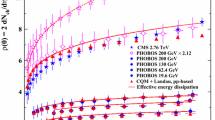Summary
Within the framework of the generalized bremsstrahlung model for high-energy collisions with charge conservation, we discuss the production of charged pions in pp and π+p collisions. Comparison with experiments of the integral multiplicity distribution function for charged pions and of the integral correlation parameters for negative pions indicates the existence of lower and higher regimes in high-energy collisions. The behavior of the elastic differential cross-section in these two energy regimes is also discussed.
Riassunto
Nel contesto del modello di bremsstrahlung generalizzato per collisioni di alta energia con conservazione della carica, si discute la produzione di pioni carichi nelle collisioni pp e π+p. Il confronto della funzione di distribuzione della molteplicità integrale per pioni carichi e dei parametri di correlazione integrale per pioni negativi con i dati sperimentali indica l’esistenza di regimi inferiori e superiori nelle collisioni di alta energia. Si discute anche l’andamento della sezione d’urto differenziale elastica in questi due regimi di energia.
Реэюме
В рамках обобшенной модели тормоэного иэлучения для сочдарений при высоких знергиях с сохранением эаряда мы обсуждаем рождение эаряженных пионов в pp и π+p соударениях. Сравнение с зкспериментальными данными для функции распределения интегральной множественности для эаряженных пионов и для интегральных корреляционных параметров для отрицательных пионов укаэывает на сушествование ниэщего и высщего режимов в соударениях при высоких знергиях. Рассматривается поведение дифференциального упругого поперечного сечения в зтих двух знергетических режимах.
Similar content being viewed by others
Literatur
E. L. Berger andA. Krzywicki:Phys. Lett.,36 B, 380 (1971).
A. Białas andK. Zalewski:Nucl. Phys.,42 B, 325 (1972).
J. Šoln:Nuovo Cimento,16 A, 624 (1973);Phys. Rev. D, to appear.
The general method of factorization of theS-matrix in the form (1) was developed inJ. Šoln:Phys. Rev. D,6, 2277 (1972);7, 1637 (1973).
H. A. Kastrup:Nucl. Phys.,1 B, 309 (1967);H. Gemmel andH. A. Kastrup:Zeits. Phys.,229, 321 (1969);Nucl. Phys.,14 B, 566 (1969);E. W. Anderson andG. B. Collins:Phys. Rev. Lett.,19, 201 (1967);G. Mack:Phys. Lett.,26 B, 515 (1968).
In the «lower regime» of high energies in which we will actually make comparison with experiments (E lab≲27 GeV), the production of secondary strange particles and antinucleons is small. SeeC. P. Wang:Phys. Rev.,180, 1463 (1969);Nuovo Cimento,64 A, 546 (1969);Phys. Lett.,30 B, 115 (1969);Phys. Lett.,32 B, 125 (1970). However, it is reasonable to assume that, as compared to the produced secondary pions, the production of secondary strange particles and antinucleons is small throughout both the «lower» and the «higher» regimes of high energies.
J. Šoln:Phys. Rev. D,8, 2340 (1973).
J. Šoln:Lett. Nuovo Cimento,9, 281 (1974).
Author information
Authors and Affiliations
Additional information
To speed up publication, the author of this paper has agreed to not receive the proofs for correction.
Rights and permissions
About this article
Cite this article
Šoln, J. Two regimes in high-energy collisions. Nuov Cim A 24, 333–352 (1974). https://doi.org/10.1007/BF02822000
Received:
Published:
Issue Date:
DOI: https://doi.org/10.1007/BF02822000



